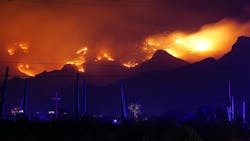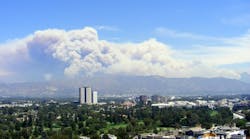In our past issues of our T&D World Wildfire Mitigation Supplement, we focused on how wildfire season is now extending well beyond its historical timeframe in North America. Indeed, in many areas, periods of high fire risk can crop up at any time of the year.
What we are now seeing is the geographic spread of high fire risk into many places around the world that formerly were not commonly associated with out-of-control blazes. In Appalachia, the Hawaiian Islands, the Pacific Northwest, the US Southwest and other places where climates were more predictable, we see superdroughts, record high temperatures, harsh winds, thunderstorms and accumulating vegetation fuel, any combination of which can be deadly. Electricity production, transmission and consumption are human activities with inherent potential to spark blazes, so the utility industry must continue to work around the clock and in all kinds of geographical and climate conditions to ensure that the next wildfire did not happen as a result of its negligence.
Several of our contributors this year spell out the severity of the problem with greater accuracy than I can, but suffice to say wildfires are growing more commonplace even as they become more deadly and dangerous. Utilities are exploring the power of predictive software, more advanced climate models and automated cameras and drones to gather a more comprehensive viewpoint on the current level of fire risk in their service territories. They strive to keep the public informed with educational outreach, mobile alerts, emergency preparedness tips and services, as well as interactive fire and outage maps.
Preparedness ahead of time is crucial, since stopping a blaze is infinitely preferable to needing to clean up and perform repairs after one. Utilities are still working to tailor their public service safety shutdown (PSPS) plans to make sure they do not interrupt service on a scale wider than what is needed to stop a fire. As always, there is no substitute for good old-fashioned vegetation management work, since most wildfires are still triggered by natural causes like tree limb contact causing a fault on a line. Devices like lightning arresters, fire-safe fuses, advanced circuit breakers, rapid earth fault current limiter (REFCL) systems, and undergrounding power lines where it makes sense to can all play key roles in making sure a blaze never catches. High technology, low technology and every solution in between are constantly under evaluation by utility engineers and researchers.
It's also worth mentioning that without data from places like the NASA Fire Information for Resource Management System and the National Oceanic and Atmospheric Administration (NOAA)’s National Weather Service, a lot of the work performed to protect us all from wildfires would be done, effectively, in the dark. Having grown up in Oklahoma, I know these services save lives.
It’s clear now that older models and historical data will not protect us from the evolving risk of wildfires, so keeping an eye on how that threat is evolving is a matter of life and death. At a time of public officials (elected and otherwise) slashing R&D spending and firing thousands of top minds after years of public service, I hope the excuse of “government efficiency” does not put us at greater risk from deadly blazes. At T&D World, we will continue to keep an eye on how public policy guides how the industry prepares for wildfires and other disasters.
Covering such a technical, multifaceted topic as wildfire mitigation every year is always a daunting task as policies, technologies, strategies and legislation change over time. However, I always look forward to this issue for those exact reasons. The same factors that make it a challenge to provide analysis for also make it endlessly interesting. Furthermore, our readership in print and online always seem to respond well to it. The past two wildfire supplements also won Azbee Awards from the American Society of Business Publication Editors (ASBPE), which are awards granted for excellent quality reporting in business-to-business, trade, association and professional publications. So, thank you for helping make this issue a success, and I hope you find our selections this year enlightening.
Read More
About the Author
Jeff Postelwait
Managing Editor
Jeff Postelwait is a writer and editor with a background in newspapers and online editing who has been writing about the electric utility industry since 2008. Jeff is senior editor for T&D World magazine and sits on the advisory board of the T&D World Conference and Exhibition. Utility Products, Power Engineering, Powergrid International and Electric Light & Power are some of the other publications in which Jeff's work has been featured. Jeff received his degree in journalism news editing from Oklahoma State University and currently operates out of Oregon.


